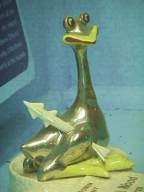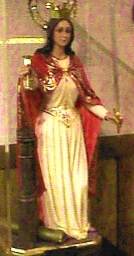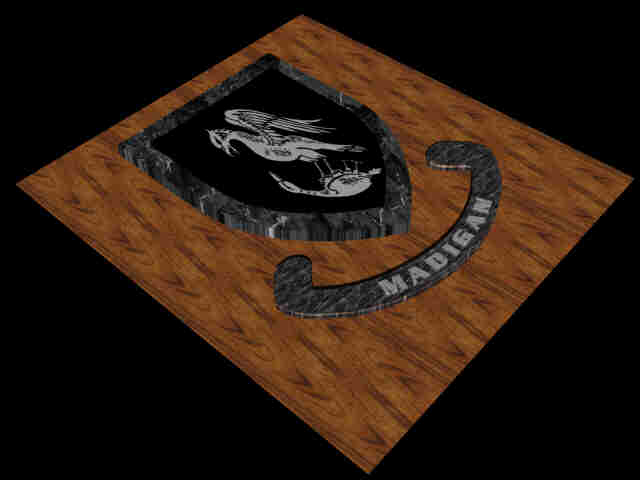Then there was a sliced
view of a large anti-aircraft (flack) shell along with a nice
description on how the timer worked which allowed the shell to
travel to a pre-determined  altitude before detonating. When the gun fires,
the sudden acceleration causes the time detonator to ignite the
gunpowder in the top ring. It burns round the ring until it
reaches a port leading down to the bottom time ring. This in turn
ignites and burns around in the opposite direction until it
reaches a port leading to the fuzz's magazine. which exploded,
detonating the shell. When the bottom time ring is rotated, it
changes the position of the connecting port and the distance from
the start of the lower ring's power train to the magazine. This
determines the time it took for the fuse to function. Laura even
got into the act when she picked up a Redeye and simulated firing
it
altitude before detonating. When the gun fires,
the sudden acceleration causes the time detonator to ignite the
gunpowder in the top ring. It burns round the ring until it
reaches a port leading down to the bottom time ring. This in turn
ignites and burns around in the opposite direction until it
reaches a port leading to the fuzz's magazine. which exploded,
detonating the shell. When the bottom time ring is rotated, it
changes the position of the connecting port and the distance from
the start of the lower ring's power train to the magazine. This
determines the time it took for the fuse to function. Laura even
got into the act when she picked up a Redeye and simulated firing
it  through
the building. The Redeye is a short-ranged, man-portable,
shoulder fired, infrared-homing missile system for use by the
front line troops. The missile is sealed in a launch tube and
cannot be removed except by firing. The system requires no
support crew or equipment in the forward area. The Redeye gunner
had to visually acquire and identify his target. He then tracked
it through a open sight while activating the missile guidance
system. A buzzer sounded when the missile had acquired the target
and was ready to fire. When the missile has been fired the launch
tube is discarded. This was the forerunner of the Stinger
missile. We found two little points of trivia for those who
delight in fascinating others with small bits of obscure
knowledge on subjects long forgotten. The Oozlefinch is the
legendary mascot
through
the building. The Redeye is a short-ranged, man-portable,
shoulder fired, infrared-homing missile system for use by the
front line troops. The missile is sealed in a launch tube and
cannot be removed except by firing. The system requires no
support crew or equipment in the forward area. The Redeye gunner
had to visually acquire and identify his target. He then tracked
it through a open sight while activating the missile guidance
system. A buzzer sounded when the missile had acquired the target
and was ready to fire. When the missile has been fired the launch
tube is discarded. This was the forerunner of the Stinger
missile. We found two little points of trivia for those who
delight in fascinating others with small bits of obscure
knowledge on subjects long forgotten. The Oozlefinch is the
legendary mascot  of Coast Artillerymen Antiaircraft Artillery and
today's Air Defense Artillerymen, The Oozlefinch is a bird of
obscure origins and is the only such creature known to exist. His
eyes are large, all seeing, unshaded by lids or eyebrows, and
rather seriously bloodshot. He is therefore forced to fly
backwards to protect his powers of observation. He may have one
feather or no feathers. Since no one has actually seen him he is
represented in a variety of ways. Since 1956 he has had a missile
tucked under one leg. In 1905 the Oozlefinch, represented by a
small figurine, became a bar mascot in the Fort Monrow, Va.
Officer's Club. This was incorporated in the coat of arms of the
Gridiron Club, a small group of Officers there. In World War I,
it was adopted, in insignia painted on the cars of the Railway
Artillery Reserve in France. At about this time, it was made part
of the distinctive unit insignia of the 43rd Air Defense
Artillery and still appears on that unit's colors. When World War
II began it appeared in various publications urging the purchase
of bonds and other promotions activities. Finally there was the
origin of Saint Barbara of the Artillerymen. According to legend,
Saint Barbara was the extremely beautiful daughter of a wealthy
of Coast Artillerymen Antiaircraft Artillery and
today's Air Defense Artillerymen, The Oozlefinch is a bird of
obscure origins and is the only such creature known to exist. His
eyes are large, all seeing, unshaded by lids or eyebrows, and
rather seriously bloodshot. He is therefore forced to fly
backwards to protect his powers of observation. He may have one
feather or no feathers. Since no one has actually seen him he is
represented in a variety of ways. Since 1956 he has had a missile
tucked under one leg. In 1905 the Oozlefinch, represented by a
small figurine, became a bar mascot in the Fort Monrow, Va.
Officer's Club. This was incorporated in the coat of arms of the
Gridiron Club, a small group of Officers there. In World War I,
it was adopted, in insignia painted on the cars of the Railway
Artillery Reserve in France. At about this time, it was made part
of the distinctive unit insignia of the 43rd Air Defense
Artillery and still appears on that unit's colors. When World War
II began it appeared in various publications urging the purchase
of bonds and other promotions activities. Finally there was the
origin of Saint Barbara of the Artillerymen. According to legend,
Saint Barbara was the extremely beautiful daughter of a wealthy  heathen
named Dioscorous who lived near Nicomedia in Asia Minor. Because
of her beauty and fearful that she be demanded in marriage and
taken away from him, he jealously shut her up in a tower to
protect her from the outside world. Shortly before embarking on a
journey he commissioned a sumptuous bathhouse to be built for
her, approving the design before he departed. Barbara had heard
of the teachings of Christ and while her father was gone she
spent much of her time in contemplation. From the windows of the
tower she looked out upon the plants, the trees and the animals
and the people. She decided that all those must be part of a
master plan and that the idols of wood and stone worshipped by
her parents must be condemned as false. Gradually she came to
accept the Christian faith. When her father returned he was
infuriated when Barbara acknowledged that she was a Christian. He
dragged her before the prefect of the province, who decreed that
she be tortured and put to death by beheading. Dioscorous himself
carried out the death sentence. On his way home he was struck by
lighting and his body was consumed. Saint Barbara lived and died
about the year 300 A.D. She was venerated as early as the seventh
century. The legend of the lighting bolt that struck her
persecutor caused her to be regarded as the Patron Saint in the
time of danger, from thunderstorms, fire and sudden death. When
gun power made its appearance in the Western world, Saint Barbara
was invoked for aid against accidents resulting from explosions
and since some of the earlier artillery pieces often blew up
instead of firing their projectiles, Saint Barbara became the
Patroness of the Artillerymen. It turned out to be an interesting
afternoon filled with almost lost secrets of a life long passed.
And thus we passed out of El Paso heading for yet another
adventure in some other part of North America.
heathen
named Dioscorous who lived near Nicomedia in Asia Minor. Because
of her beauty and fearful that she be demanded in marriage and
taken away from him, he jealously shut her up in a tower to
protect her from the outside world. Shortly before embarking on a
journey he commissioned a sumptuous bathhouse to be built for
her, approving the design before he departed. Barbara had heard
of the teachings of Christ and while her father was gone she
spent much of her time in contemplation. From the windows of the
tower she looked out upon the plants, the trees and the animals
and the people. She decided that all those must be part of a
master plan and that the idols of wood and stone worshipped by
her parents must be condemned as false. Gradually she came to
accept the Christian faith. When her father returned he was
infuriated when Barbara acknowledged that she was a Christian. He
dragged her before the prefect of the province, who decreed that
she be tortured and put to death by beheading. Dioscorous himself
carried out the death sentence. On his way home he was struck by
lighting and his body was consumed. Saint Barbara lived and died
about the year 300 A.D. She was venerated as early as the seventh
century. The legend of the lighting bolt that struck her
persecutor caused her to be regarded as the Patron Saint in the
time of danger, from thunderstorms, fire and sudden death. When
gun power made its appearance in the Western world, Saint Barbara
was invoked for aid against accidents resulting from explosions
and since some of the earlier artillery pieces often blew up
instead of firing their projectiles, Saint Barbara became the
Patroness of the Artillerymen. It turned out to be an interesting
afternoon filled with almost lost secrets of a life long passed.
And thus we passed out of El Paso heading for yet another
adventure in some other part of North America.
***THE END ***

